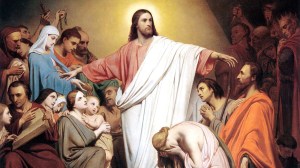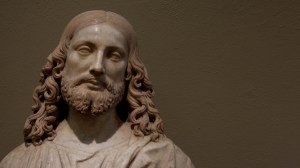In this series

Mary
18 B.C.?-A.D. 48? History’s most venerated mother
Though Mary plays a key role in the birth stories of Matthew and Luke, she is scarcely mentioned in the other two Gospels and not at all in the New Testament letters. Yet Mary today is the most venerated woman in history.
Roman Catholic tradition says she was born in Jerusalem to Joachim and Anne, who were elderly and childless. Gospel references begin when she was probably about 14 years old, already engaged to a man named Joseph (Jewish women were generally married shortly after they could have children). Luke reported that while Mary was living with her parents in Nazareth, an angel visited her and told her she would give birth to a holy child who would be called “the Son of God.”
Though the stories began with a miracle, Mary later appeared confused or in doubt about Jesus’ mission. She was once convinced he had gone mad, and tried to get him to stop preaching and come home.
Christian tradition quickly asserted that Mary remained a virgin all of her life. The first reference is the apocryphal Protevangelium of James, an embellished story of Jesus’ infancy. Early church leaders such as Irenaeus and Clement of Alexandria believed Mary remained a virgin, and Athanasius wrote extensively on the “ever virgin” Mary.
The Gospel accounts record that Jesus had brothers and sisters, but Roman Catholics, following the lead of many early church leaders, argue they were Jesus’ cousins or Joseph’s children from a previous marriage. Protestants have taught Mary was a virgin only until the birth of Jesus, after which she and Joseph conceived James, Joses, Judas, Simon, and unnamed daughters.
Mary was present at the Day of Pentecost, but then she disappears from history. One tradition says she lived in Jerusalem until she died, in A.D. 48, at about age 66. Another says she moved to Ephesus. Still another, asserted by Gregory of Tours (d. 593) based on earlier apocryphal writings, says that when she died, her body was “borne on a cloud into paradise, where it was reunited with her soul and now rejoices with the elect.”
Mary slowly grew in importance to early Christians; at first she was considered the new Eve. By the fourth century, she was given the title theotokos, the “God bearer,” and was increasingly seen as a compassionate intercessor to whom believers could pray.
By the Middle Ages, English historian Eadmer taught that Mary was herself conceived without original sin. This belief, along with that of her “Assumption” (rise to heaven) grew to such an extent in Roman Catholic circles that today they are part of that church’s official doctrine.
Today, many people (not just Roman Catholics and Orthodox) claim to experience visions of Mary, and she remains an important object of devotion for millions.
John the Baptist
4 B.C.?-A.D. 27? Essene Elijah?
Though born into a priestly family, as an adult John rejected the life of his father. Instead, he became a prophet who lived alone in the desert, ate honey and locusts, and wore camel hair clothing. Like Old Testament prophets (with similar dress and diets), John urged people to repent. But he also used the ritual of baptism as a dramatic and public symbol of washing away sins.
Some scholars have suggested that John had once been a member of the Essene sect in Qumran, the community famous for preserving the Dead Sea Scrolls. Like John, these Jews lived in the Judean wilderness and even had rules on how to eat honey and locusts. They also performed daily ritual cleansing similar to baptism, and their documents confirm that they eagerly anticipated the arrival of a Messiah promised by the prophets.
But instead of awaiting the Messiah, John saw Jesus and announced the arrival of one: “Look, the Lamb of God, who takes away the sin of the world!” A short time after Jesus began his ministry, John was beheaded by Galilean ruler Herod Antipas for condemning Herod’s marriage to the ex-wife of Herod’s half-brother, Philip.
Peter
died c. A.D. 64 Top of the list
Simon bar Jona (son of Jonah) was a fisherman who lived in Capernaum when he, with his brother Andrew, was invited by Jesus to join his ministry.
Jesus renamed him Peter (petros in Greek, or “the rock”) and he quickly became a leader of the other 11 followers: in every list of apostles, he is named first.
Peter was also the first apostle to recognize Jesus as Messiah and Son of God. In response, Jesus said, “On this rock I will build my church.” From this, Roman Catholics have concluded Peter was the first pope.
Ironically, Peter is probably best known not for overseeing the church but for denying he was one of Jesus’ disciples. Still, after Jesus was gone, he took control of the movement, designating a successor for Judas, acting as spokesman, speaking to thousands at Pentecost. Years later, when believers faced a potential split, Peter sided with Paul in arguing that Christians were not required to observe Jewish laws. He later changed his mind, earning Paul’s ire.
Two New Testament letters are attributed to Peter, but his name was used pseudonymously (i.e., appended to letters he could not have written) several times through the sixth century—the Apocalypse of Peter, the Gospel of Peter, Preaching of Peter, Acts of Peter, Acts of Peter and Paul, Passion of Peter and Paul, and Martyrdom of Peter.
Peter’s recollections of Jesus were said to be the basis for the Gospel of Mark. Papias, an early church writer, said, “Mark became Peter’s interpreter and wrote accurately all that he remembered … of the things said or done by the Lord.”
Early Christian writers also reported that Peter was crucified upside down (his requested position) in Rome when Nero persecuted Christians in A.D. 64.
James and John
died c. A.D. 50 and 95 Tough and tender
James and John were brothers, the sons of Salome and Zebedee, a Galilean fisherman who owned a fleet of boats. The brothers were mending their nets when Jesus invited them to follow him.
Both men were brazen and hot-tempered, and it is possibly for this reason that Jesus nicknamed them Boanerges: “Sons of Thunder.” Once, when Samaritans failed to treat Jesus hospitably, they asked, “Lord, do you want us to call fire down from heaven to destroy them?” Jesus declined the offer. Another time they boldly asked Jesus if they could have the seats of honor beside him when he became king.
In spite of their impertinence, Jesus accepted them with Peter into his inner circle. They alone were allowed to see Jesus raise the daughter of Jairus from the dead, to witness the Transfiguration, and to pray nearest him in the Garden of Gethsemane on the night of his arrest. John is thought by some scholars to have been the unnamed disciple into whose care the dying Jesus entrusted his mother.
James became the first apostle martyred (either beheaded or run through with a sword by Herod Agrippa I) and the only one whose death is reported in the New Testament. According to one tradition, popularized by Clement of Alexandria, James converted the servant accompanying him, who shared in his death. Another tradition (likely begun in the seventh century) alleges that he preached in Spain before his martyrdom.
John, according to some traditions, was martyred with his brother. More persistent traditions preserved by writers like Eusebius say John outlived the other apostles and in his old age moved to Asia Minor and settled at Ephesus. During persecution of Christians by Emperor Domitian, he was exiled to a small island, Patmos, where he wrote the Book of Revelation. A later Latin legend recounts how Domitian ordered John to be thrown into a vat of boiling oil, but he came out unscathed.
Once freed, he returned to Ephesus to write the Gospel and the three letters bearing his name. Modern scholars debate the full extent of his authorship, but most associate John with the fourth Gospel not only because of tradition but because he is the only apostle whose name is missing from the book.
Jerome, a fourth-century church scholar, said that when John was old and feeble, he was carried to Christian gatherings where he gave a single message: “Little children, love one another.”
Stephen Miller is a free-lance writer and former editor of Illustrated Bible Life. He is an editorial adviser for Christian History.
Copyright © 1998 by the author or Christianity Today/Christian History magazine. Click here for reprint information on Christian History.













